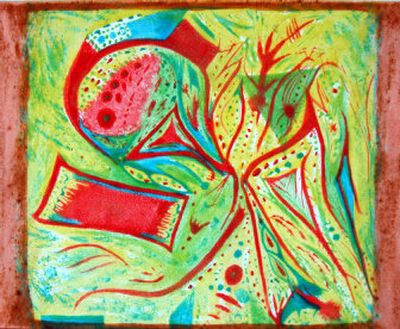Prisoner punished for painting postcards

SAN FRANCISCO – A convicted killer who sold postcard-sized paintings he created with dye from M&Ms and brushes fashioned from his hair broke prison rules by running an unauthorized business out of his cell, officials said.
While Donny Johnson hasn’t profited from his art – all the money is being used to start a program for children of inmates – prison officials said he was wrongfully engaged in a business without the warden’s permission.
Johnson, 46, has been locked up since 1980 for second-degree murder in a drug-related killing. In 1989, he was convicted of assaulting one guard and slashing the throat of another. He’s now serving life without parole in the most secure unit at Pelican Bay State Prison in Crescent City, about 10 miles south of the Oregon border.
The details of possible disciplinary action were unclear. A hearing on the matter will be held in the next few weeks, said Terry Thornton, a spokeswoman for the state Department of Corrections and Rehabilitation.
His lawyer, Charles Carbone, disputed that Johnson violated the rules.
“There’s a very large question mark over the legality and morality of what the department has done to punish an inmate for trying to better himself and better his community,” he said.
To alleviate boredom and loneliness, Johnson turned to art and got the attention of Stephen Kurtz, a semiretired psychoanalyst who runs the nonprofit Pelican Bay Prison Project and became a pen-pal with Johnson four years ago.
When Johnson starting sending paintings to him in Mexico about a year ago, Kurtz said, he and his wife, an artist, were stunned.
“We looked at these things and said, ‘These are damn good,’ ” Kurtz said. When he learned how Johnson created his tiny abstract works, he was even more impressed.
Because he’s not allowed to have any art materials in his cell, Johnson orders “supplies” from the prison commissary. Once a month, he buys 10 packs of M&Ms at 60 cents each. He then puts a few candies in small plastic jelly containers, adds water and soaks the candies. Johnson’s “paint” is left behind. His brush is made of plastic wrap, foil and strands of his own hair. He then layers blank postcards with vibrant colors, shapes and spirals.
Kurtz organized a showing in Mexico last month. Nearly 500 people packed into a gallery where a giant bowl of M&Ms greeted them at the entrance. Twenty paintings have sold at $500 apiece, Kurtz said.
Johnson’s mother had no idea her son had any artistic talent.
“He just found an outlet for his energy,” Helen Grimes, a Hayward nurse, said. “He says, ‘When I paint I leave the room. … You just go into your own space and time.’ It really helps him survive.”